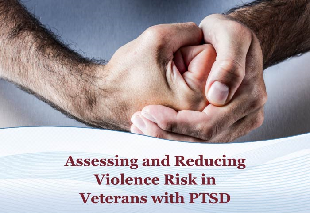PTSD: National Center for PTSD
Research Findings on PTSD and Violence
Research Findings on PTSD and Violence
Overview
Individuals with PTSD are not dangerous. Although PTSD is associated with an increased risk of violence, the majority of Veterans and non-Veterans with PTSD have never engaged in violence. When other factors like alcohol and drug misuse, additional psychiatric disorders, or younger age are considered, the association between PTSD and violence is decreased.
How Is Violence Defined?
Violence is inflicting or threatening to inflict serious physical harm on another person. Examples include beating someone, physically forcing someone to have sex, or using or threatening to use a gun or knife (1).
When reviewing research or media reports about violence and PTSD, it is important to pay close attention to how violence is defined. Milder forms of aggression such as slapping, threatening to throw something, or pushing have sometimes been labeled as violence. Similarly, criminal behavior has sometimes been used interchangeably with violence even though most criminal behavior is non-violent. Including these behaviors in measures of violence falsely inflates reported rates of violence among people with and without PTSD.
Continuing Education Course
Assessing and Reducing Violence Risk in Veterans with PTSD
This PTSD 101 online course describes an evidence-based approach for improving clinical assessment and risk management of violence in Veterans with PTSD.
In This Article
Understanding Violence and PTSD
The best epidemiological evidence on violence and PTSD comes from studies of the U.S. general population and of post-9/11 Veterans in the U.S. and the United Kingdom. According to these studies, the prevalence of violence among individuals with PTSD ranged from 7.5% among US adults to 8.6% to 19.5% among post-9/11 Veterans (2-4). In the same studies, the prevalence of violence ranged from 2.0% in US adults with no mental health disorders and 3.0 to 6.4% among post-9/11 Veterans without PTSD.
There have been no comparable studies of PTSD and violence in other Veteran cohorts. However, a large epidemiological study of Vietnam and Vietnam-era Veterans that was conducted in the mid-1980s examined intimate partner violence (ranging from slapping and pushing to using a knife or gun), and found that 33.0% of Veterans with PTSD compared to 13.5% of those without PTSD reported intimate partner violence in the past year (1).
Interpreting Findings on the Relationship Between PTSD and Violence
Individuals with PTSD have an elevated prevalence of risk factors that are associated with increased violence, such as substance misuse and comorbid psychiatric disorders. Because of this, findings regarding the relationship between PTSD and violence should be interpreted cautiously if they are based on analyses that do not take risk factors other than PTSD into account. For example, in a study of a representative sample from the U.S. population excluding combat Veterans, PTSD was associated with increased risk of violence (7% compared to 3% among those without PTSD). However, when alcohol use and anger severity were controlled, PTSD was no longer statistically associated with an increased risk of violence (5). Similarly, in one study of Veterans who served post-9/11, PTSD when examined on its own was associated with an increased risk of violence. However, when alcohol misuse was statistically controlled, PTSD was no longer associated with an increased risk of violence (3). The prevalence of violence in PTSD is comparable to the prevalence in anxiety and depressive disorders, which ranges from 5.0% to 11.7% (2,5). The prevalence of violence is higher among individuals with alcohol or substance misuse (range = 9.1% to 34.7%) (2,6,7). Furthermore, the more diagnoses someone has, the greater the likelihood of violence.
Considerations Regarding Violence Among Post-9/11 Veterans with PTSD
The data showing that the prevalence of violence among individuals with PTSD is 7.5% in the US population and 19.5% in post-9/11 Veterans suggest that the association between PTSD and violence is especially strong in this Veteran cohort. However, to understand these findings, it is important to consider that post-9/11 Veterans are relatively young (median age = 34) and that younger age is associated with increased risk of violence (2-4). For example, in the National Comorbidity Survey of the US general population, the prevalence of violence in the past year was 32.7% among men between the ages of 25-34 but only 1.3% among men aged 35-44 (2). Findings like these suggest that age and perhaps other demographic characteristics need to be considered when comparing the post-9/11 cohort with non-Veterans or with Veterans of other eras.
Conclusions
Although PTSD is associated with increased risk of violence, most people with PTSD have never engaged in violence. Research suggests that when risk and protective factors correlated with PTSD are considered, the association between PTSD and violence diminishes (2,3). Consequently, it is important to consider a wide array of risk factors in addition to PTSD in order to understand the relationship between PTSD and violence.
Learn more about Assessing Risk of Violence in Individuals with PTSD.
References
- Jordan, K. B., Marmar, C. R., Fairbank, J. A., Schlenger, W. E., Kulka, R. A., Hough, R. L., & Weiss, D. S. (1992). Problems in families of male Vietnam Veterans with posttraumatic stress disorder. Journal of Consulting and Clinical Psychology, 60, 916-926. doi: 10.1037//0022-006X.60.6.916
- Corrigan, P. W., & Watson, A. C. (2005). Findings from the National Comorbidity Survey on the frequency of violent behavior in individuals with psychiatric disorders. Psychiatry Research, 136, 153-162.
- Elbogen, E. B., Johnson, S. C., Wagner, H. R., Sullivan, C., Taft, C. T., & Beckham, J. C. (2014). Violent behaviour and post-traumatic stress disorder in US Iraq and Afghanistan Veterans. British Journal of Psychiatry. Advance online publication. doi: 10.1192/bjp.bp.113.134627
- MacManus, D., Dean, K., Jones, M., Rona, R. J., Greenberg, N., Hull, L., Fahy, T., Wessely, S., & fear, N. T. (2013). Violent offending by UK military personnel deployed to Iraq and Afghanistan: a data linkage cohort study. Lancet, 381, 907-917. doi: 10.1016/S0140-6736(13)60354-2
- Blakey, S. M., Love, H., Lindquist, L., Beckham, J. C., & Elbogen, E. B. (2017). Disentangling the link between posttraumatic stress disorder and violent behavior: Findings from a nationally representative sample. Journal of Consulting and Clinical Psychology. Advance online publication. doi:10.1037/ccp0000253
- Swanson, J. W., Holzer, C. E., Ganju, V. K., & Jono, R. T. (1990). Violence and psychiatric disorder in the community: Evidence from the Epidemiologic Catchment Area surveys. Hospital and Community Psychiatry; 41, 761-770.
- Elbogen, E. B., Johnson, S. C., Wagner, H. R., Newton, V. M., Timko, C., Vasterling, J. J., & Beckham, J. C. (2012). Protective factors and risk modification of violence in Iraq and Afghanistan War Veterans. Journal of Clinical Psychiatry, 73, 767-773. doi: 10.4088/JCP.11m07593
- Coid, J., Yang, M., Roberts, A., Ullrich, S., Moran, P., Bebbington, P., Brugha, T., Jenkins, R., Farrell, M., Lewis, G. & Singleton, N. (2006). Violence and psychiatric morbidity in a national household population: A report from the British Household Survey. American Journal of Epidemiology, 164, 1199-1208.
You May Also Be Interested In

Continuing Education Online Courses
Learn from expert researchers and earn free Continuing Education (CE) credits.


























